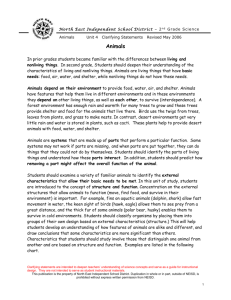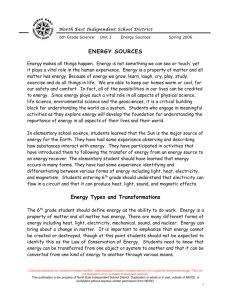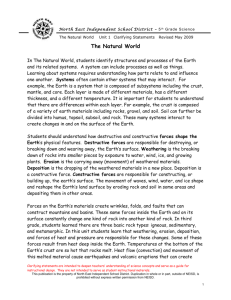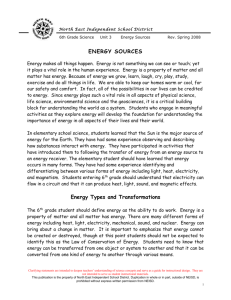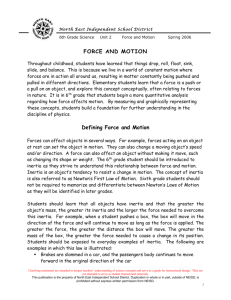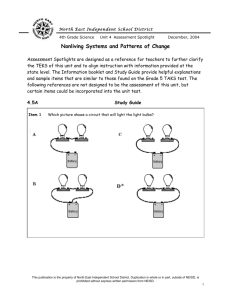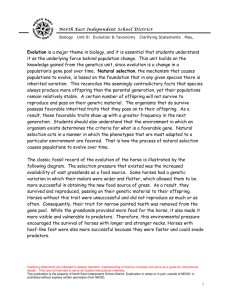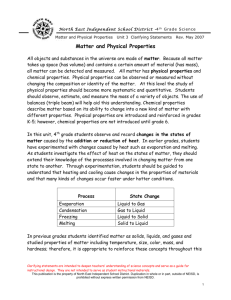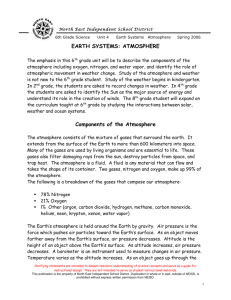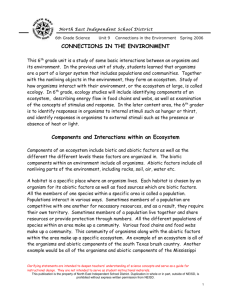6th grade Earth-Water - North East Independent School District
advertisement
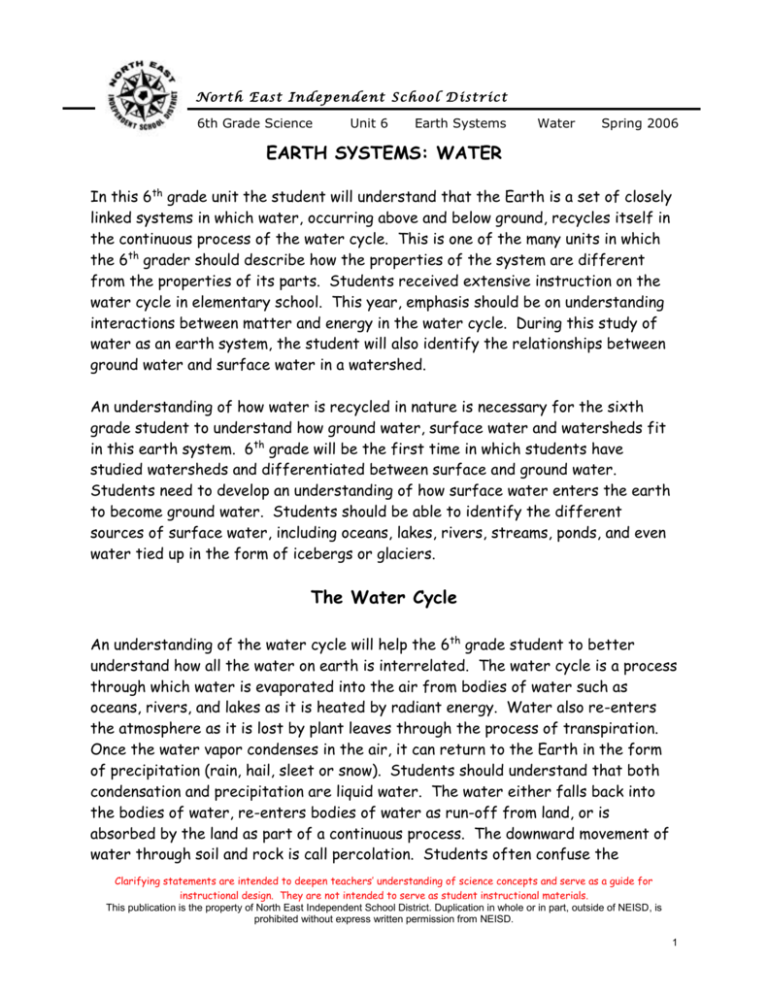
N o r t h E a st I n d ep en d e nt S c h o o l D i st ric t 6th Grade Science Unit 6 Earth Systems Water Spring 2006 EARTH SYSTEMS: WATER In this 6th grade unit the student will understand that the Earth is a set of closely linked systems in which water, occurring above and below ground, recycles itself in the continuous process of the water cycle. This is one of the many units in which the 6th grader should describe how the properties of the system are different from the properties of its parts. Students received extensive instruction on the water cycle in elementary school. This year, emphasis should be on understanding interactions between matter and energy in the water cycle. During this study of water as an earth system, the student will also identify the relationships between ground water and surface water in a watershed. An understanding of how water is recycled in nature is necessary for the sixth grade student to understand how ground water, surface water and watersheds fit in this earth system. 6th grade will be the first time in which students have studied watersheds and differentiated between surface and ground water. Students need to develop an understanding of how surface water enters the earth to become ground water. Students should be able to identify the different sources of surface water, including oceans, lakes, rivers, streams, ponds, and even water tied up in the form of icebergs or glaciers. The Water Cycle An understanding of the water cycle will help the 6th grade student to better understand how all the water on earth is interrelated. The water cycle is a process through which water is evaporated into the air from bodies of water such as oceans, rivers, and lakes as it is heated by radiant energy. Water also re-enters the atmosphere as it is lost by plant leaves through the process of transpiration. Once the water vapor condenses in the air, it can return to the Earth in the form of precipitation (rain, hail, sleet or snow). Students should understand that both condensation and precipitation are liquid water. The water either falls back into the bodies of water, re-enters bodies of water as run-off from land, or is absorbed by the land as part of a continuous process. The downward movement of water through soil and rock is call percolation. Students often confuse the Clarifying statements are intended to deepen teachers’ understanding of science concepts and serve as a guide for instructional design. They are not intended to serve as student instructional materials. This publication is the property of North East Independent School District. Duplication in whole or in part, outside of NEISD, is prohibited without express written permission from NEISD. 1 N o r t h E a st I n d ep en d e nt S c h o o l D i st ric t 6th Grade Science Unit 6 Earth Systems Water Spring 2006 processes of run-off and percolation. They should be able to differentiate between the two by recognizing that each process returns water to a different location. Run-off returns water to surface water sources, or bodies of water that occur above ground. Percolation returns water to ground water sources. This water is sometimes referred to as recharge, such as when it returns water to aquifers. Surface Water Surface water can be either marine (saltwater) or fresh. Most of the Earth’s surface water is located in the oceans. A much smaller amount is available for human use in fresh water sources. Fresh water that remains at the Earth’s surface does so by becoming part of a pond, creek, stream, river, lake or frozen as an iceberg or glacier. Streams and rivers are moving bodies of freshwater. Streams and rivers contribute to the process of runoff in the water cycle. Ponds and lakes are bodies of standing water created when fresh water forms in depressions found on Earth. In ponds, the water is usually shallow. Most ponds are so small that they may not exist all year. The pond might dry up allowing the water Clarifying statements are intended to deepen teachers’ understanding of science concepts and serve as a guide for instructional design. They are not intended to serve as student instructional materials. This publication is the property of North East Independent School District. Duplication in whole or in part, outside of NEISD, is prohibited without express written permission from NEISD. 2 N o r t h E a st I n d ep en d e nt S c h o o l D i st ric t 6th Grade Science Unit 6 Earth Systems Water Spring 2006 to re-enter the water cycle by evaporation, or the pond may freeze during the winter. Lakes are much larger than ponds an can be formed in many ways. A lake can form from a depression left on the Earth’s surface by ice that melted from a previous Ice Age. A lake can form in the crater of an old volcano. Sometimes a lake is created by placing a dam along a river to back up the water. If a lake stores water for human use it is known as a reservoir. Usable fresh water is not always plentiful enough for people’s needs. There are many reasons for this. One is that the number of people using water on earth is increasing. Another reason is that there are times when places on earth go through a period of drought. Drought occurs when rainfall is below average for a long period of time. Water supplies during a drought have to be conserved. This is because the total amount of the water on Earth does not change. It just gets recycled naturally through the water cycle. Watersheds Lessons on watersheds easily allow instructors to discuss systems. Streams become tributaries and tributaries become rivers. A region of land that is drained by a river system is known as a watershed or drainage basin. There are more than 40 rivers and 11,000 streams in Texas. Texas has 15 major river basins. Everyone lives in a watershed. A ridge or other type of elevated land is called a divide, and this separates one watershed from another. A watershed can be quite large such as one that runs into the ocean or very small such as one that drains into a pond. The largest watershed in the United States is the Mississippi River watershed. In Bexar county all the creeks and streams eventually flow into the Medina or San Antonio Rivers. Further downstream, the Medina River joins the San Antonio River which eventually empties into the Gulf of Mexico. In the United States, the Rocky Mountains divide the country as the mountain chain runs north to south. This is known as the Continental Divide. Rain that falls to the east of the Rockies drains into the Atlantic Ocean or the Gulf of Mexico. Rain that falls to the west of the Rocky Mountains drains into the Pacific Ocean. This system of drainage makes it important to take care of the water on Earth. Runoff collects soil through the process of erosion. If the soil has been contaminated in any way, then the runoff Clarifying statements are intended to deepen teachers’ understanding of science concepts and serve as a guide for instructional design. They are not intended to serve as student instructional materials. This publication is the property of North East Independent School District. Duplication in whole or in part, outside of NEISD, is prohibited without express written permission from NEISD. 3 N o r t h E a st I n d ep en d e nt S c h o o l D i st ric t 6th Grade Science Unit 6 Earth Systems Water Spring 2006 will carry the pollution along with it and may spread the pollution to other areas. The following diagram illustrates the structure of a watershed: Ground Water Precipitation that hits the ground may not drain into a stream or tributary. It might soak into the ground like water can soak into a sponge. This occurs because most of the materials beneath the Earth’s surface are porous, meaning that they have tiny holes that can have water filter through them. The process through which water moves through porous rock and soil is known as percolation. The water will be carried downward due to gravity through different layers of soil until the water is finally stopped by a layer that has pores too small, and the water is trapped. This is how groundwater forms an aquifer. An aquifer acts like a storage place for groundwater. The area above ground where water enters the aquifer is known as the recharge zone. Water below the ground does not just stay still. An aquifer is like a river underground except it flows at a much slower rate. Ground water is one of the most important sources of freshwater. This underground water is used in farming and in industry. People also use the water found in aquifers as drinking water. This water is referred to as potable because it is safe to drink. Clarifying statements are intended to deepen teachers’ understanding of science concepts and serve as a guide for instructional design. They are not intended to serve as student instructional materials. This publication is the property of North East Independent School District. Duplication in whole or in part, outside of NEISD, is prohibited without express written permission from NEISD. 4 N o r t h E a st I n d ep en d e nt S c h o o l D i st ric t 6th Grade Science Unit 6 Earth Systems Water Spring 2006 Aquifers generally form in areas where earth materials are permeable, such as ground underlain with limestone and sandstone. Texas has many aquifers. The aquifer below the San Antonio area is the Edwards Aquifer. Students do not need to memorize specific information about the Edwards Aquifer, but they should be aware of its existence and importance. The following map illustrates its boundaries: Clarifying statements are intended to deepen teachers’ understanding of science concepts and serve as a guide for instructional design. They are not intended to serve as student instructional materials. This publication is the property of North East Independent School District. Duplication in whole or in part, outside of NEISD, is prohibited without express written permission from NEISD. 5
